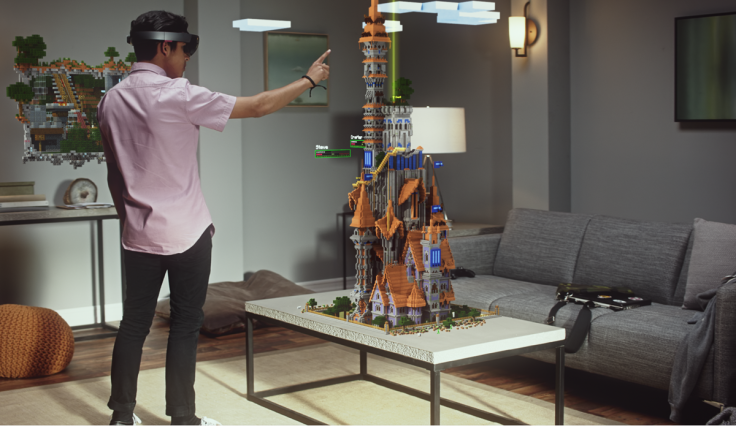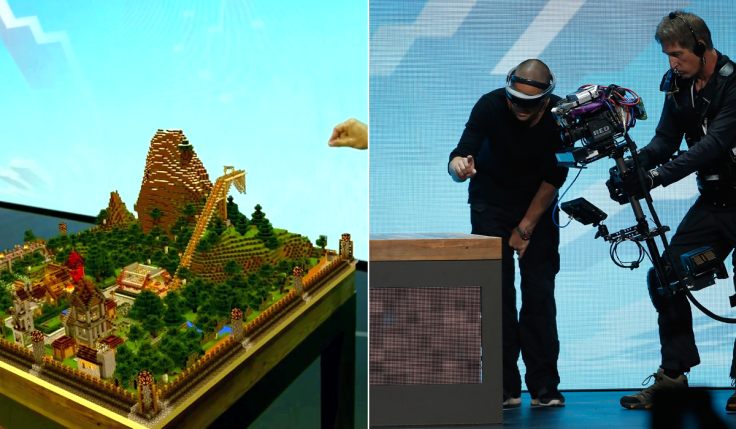E3 2015: How Microsoft's HoloLens could impact Fifa, Call of Duty, eSports and more

Undoubtedly one of the best moments of E3 2015 was the HoloLens demo at Microsoft's conference. Live on stage, with help from a specially designed camera, they showed off their augmented reality (AR) headset with Minecraft. It blew people away.
Used in tandem with existing versions of the game (presumably on PC and Xbox only) HoloLens will allow players to take the Minecraft world out of the screen into the real world, where they can inspect it in great deal and influence it to help or hinder players on their server.
Seeing the blocky creations of the demo world rise up from that table, the fellow player walking through it and the ways HoloLens allows players to see inside buildings and below the surface – it was unreal to see the concept hinted at in the headset's reveal video brought to life.
However, like the biggest surprises at Sony's press conference, the HoloLens demo gets less impressive the more you think about it. The features only go so far and those alone won't justify buying a whole – likely expensive – piece of kit. Nobody can deny though that as a proof of concept it was perfect – sparking interest and inspiring developers.
It all leads to the inevitable question: what applications could this impressive technology have for gaming?
What immediately springs to mind are features not far removed from the kind of second-screen experiences once being flouted by Microsoft with their Smartglass phone and tablet app. These apps offered gameplay features on additional screens, but never gave people a good enough reason to choose a smaller screen over the bigger one with all the action and fun on it.
It's easy to imagine a Minecraft companion app offering similar features to what we saw in the HoloLens demo. The key difference is immersion, that awful but necessary buzz word. Being able to see the game world from a wholly different perspective, and with such a level of interactivity, will bring features alive and make them fun in a whole new way.

To cite two mainstream series, imagine seeing an entire Battlefield or Call of Duty map brought to life with HoloLens, giving players the ability to offer advice and objectives to the teams "on the ground". There could be whole modes built around this idea.
Sports games like Fifa, Madden, NBA could play out on tabletops like a futuristic Subbuteo, not just for players but for spectators too. Keeping things sporty, this could also be a route for sports management sims like Football Manager to take, with a touchline view of the action and the ability to issue tactical changes and salute players Tim Sherwood-style from a virtual dug out.
This naturally brings us to eSports, where HoloLens could offer spectators a new method to watch the world's best players compete in League of Legends, Dota 2 or many of the aforementioned games.
Depending on the level of interactivity HoloLens can offer, we could see more first person puzzle games make a comeback. Using a PS4-exclusive example unlikely to ever have functionality with Microsoft's headset, Jonathan Blow's The Witness is the kind of exploratory puzzle game that could mix beautiful imagery on screen with puzzles needing a real-life perspective to complete.

HoloLens could also solve a dilemma developers have been pondering for years, and offer a way for real time strategy (RTS) games to thrive on console. Creative Assembly's Total War series could bring large scale war to your house. Theoretically it could also map battlefields specifically to certain rooms – making mountains of your furniture. Then there are other smaller scale RTS titles like The Banner Saga.
One genre gathering dust which could be revamped with AR is the racer – not racers as in Forza (though HoloLens show rooms are inevitable) – but racers like Micro Machines and Mashed, which again could turn real life environments into race tracks given the right tech. While not quite in that same category, Ubisoft's Trials series is another which could make use of the tech.
There's a wealth of possibilities for Microsoft's HoloLens but the tech will still need to prove its worth as a product of its own, not just as an add-on or peripheral. This may well come through real world applications – particularly in the world of production and design, but also in the lives of ordinary people.
The possibilities above all sound cool, but they're in the periphery, sideshows to core games. They may sound fun, but HoloLens' monetary worth won't be balanced with these kinds of features alone.
For the latest video game news follow us on Twitter @IBTGamesUK.
© Copyright IBTimes 2025. All rights reserved.




















